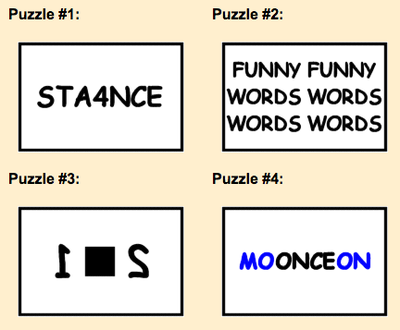

Notice that all of these punctuation marks represent pauses (interruptions) in grammar. Rebus Puzzle Examples One form of rebus puzzles uses pictures to spell out a complete message. In the first paragraph, for example, the period appears before the comma which is before the hyphen which is before the pair of brackets (considered part of a unit) and so we have There are two types of rebus puzzles that work as engaging brainteasers: puzzles that use pictures and symbols, and puzzles that use word positioning to form idioms.

The really clever thing going on here is that if we read the paragraph before each equation, we see the punctuation marks appearing in the exact order that they appear in the equations. You have to use your imagination a little as, for example, a ? is represented by a right bracket over a vertical line over a period. Whenever we see a division symbol, this represents that we put one symbol over the other, so a semicolon is a period over a comma, and a colon is a period over a period. We must watch for where they appear in the text Suspicious.Ĭombine the keyword in the title with the tags and knowledge in a logical way. Hmmm, each blockquote is preceded by a block of rambling text. Fortunately the path to solve involves more than the numbered equations. For this to be true, what should be the "diameter" of a regular pentagon?Ī) The distance between the farthest corners of the pentagon.ī) The diameter of the largest circle that fits inside the pentagon.Ĭ) The diameter of the smallest circle that fits around the pentagon.ĭ) The distance from the base to the opposite corner of the pentagon.To start, here are some basic relationships - creative thinking may help (or not)Įqual signs represent approximate equality, 2 being the most suspect a=c might also be a good approximation.

It turns out that for the appropriate definition of the "diameter" of a regular pentagon, if we define the number theta to be the ratio of the perimeter/diameter of any regular pentagon, then its area is always thetar^2, where r is half of the diameter. Is it a sheer coincidence that they are both the same pi, even though one concerns the circumference and one concerns the area? No! We also all know that the area of a circle is pir^2. The number pi is defined to be the ratio circumference/diameter for any circle.


 0 kommentar(er)
0 kommentar(er)
